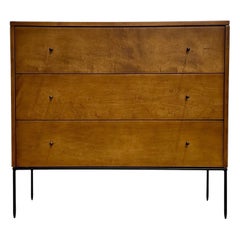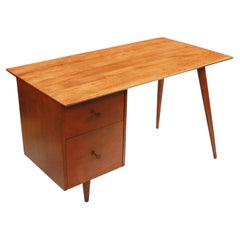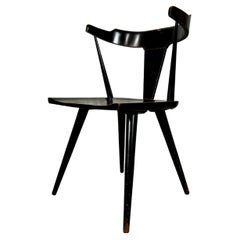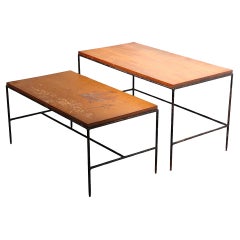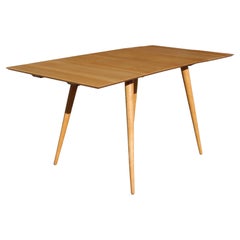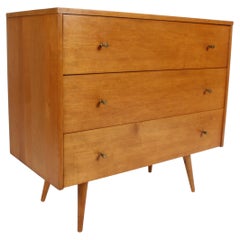Winchendon Furniture
to
5
46
4
50
48
50
46
3
27
5
3
49
35
28
17
7
48
47
50
50
50
24
8,652
3,917
2,530
2,229
Creator: Winchendon
Paul McCobb Planner Group Dresser - Mid Century Modern Three Drawer Chest
By Paul McCobb, Winchendon, Planner Group
Located in Decatur, GA
Stellar three drawer Planner Group chest by Paul McCobb for Winchendon, circa 1950s. Black wrought iron base and teardrop pulls.
Fully restored and ready for use. Excellent condition...
Category
1950s American Mid-Century Modern Vintage Winchendon Furniture
Materials
Iron, Wrought Iron
Original 1950s Mid-Century Modern Desk by Paul McCobb for Planner Group
By Winchendon, Paul McCobb
Located in Lafayette, IN
This fantastic little desk is an original 1950s piece designed by the renowned Paul McCobb for the Planner Group and manufactured by the Winchendon Furniture Company. Desk has lots o...
Category
1950s American Mid-Century Modern Vintage Winchendon Furniture
Materials
Wood
$1,799 Sale Price
28% Off
Paul McCobb Planner Group Black Lacquered T-Back Dining Chair
By Paul McCobb, Winchendon
Located in Denton, TX
Very sturdy with worn black lacquer makes this chair a great companion for a desk or in a corner of a room, Original finish.
Category
Mid-20th Century North American Mid-Century Modern Winchendon Furniture
Materials
Maple, Lacquer
McCobb for Winchendon Planner Group Nesting Tables c 1950's
By Paul McCobb, Winchendon
Located in New York, NY
Rare set of nesting tables designed by Paul McCobb for Winchendon Furniture. The rectangular tables nest, for easy storage and display. Both tables are selling in as is, as found condition, both show significant cosmetic wear, and will need to be refinished, the smaller table is missing the screw in end cap feet, please see images. Although the tables need some restoration, they are an unusual and hard to find form, and will clean up nicely as the tops are solid wood, and the wrought iron frames can easily be repainted.
Larger Table 36 W x 18.5 D x 20 H inches
Smaller Table 24...
Category
Mid-20th Century American Mid-Century Modern Winchendon Furniture
Materials
Wrought Iron
Maple Extension Dining Table by Paul McCobb, Planner Group
By Paul McCobb, Winchendon
Located in Palm Springs, CA
Maple extension dining table by Paul McCobb for Winchendon Furniture, "Planner Group". Table with both inserts measure 60" wide. Each extension is 10" wide. Table without extension i...
Category
1950s American Mid-Century Modern Vintage Winchendon Furniture
Materials
Wood, Maple
Paul McCobb for Planner Group MCM Blond or Ebony Maple Three-Drawer Chest
By Planner Group, Paul McCobb, Winchendon
Located in St. Louis, MO
Single Paul McCobb Planner Group chest / dressers for Winchendon. Three drawers with solid brass cone pulls on angled tapered legs. The chest is shown sold, but have another in a mor...
Category
1950s American Mid-Century Modern Vintage Winchendon Furniture
Materials
Maple
Paul McCobb Planner Group Black Drop Leaf Dining Table
By Planner Group, Paul McCobb, Winchendon
Located in Bainbridge, NY
American Mid Century Modern Paul McCobb #1524 Black Drop Leaf Table. Featuring a rectangular piano hinged Black enameled solid wooden form on rounded tapered legs. Table open 56"L. ...
Category
1950s American Mid-Century Modern Vintage Winchendon Furniture
Materials
Birch
Paul McCobb Planner Group Model 1507-S Dresser and Mirror for Winchendon
By Planner Group, Paul McCobb, Winchendon
Located in Littleton, CO
Paul McCobb’s Model 1507-S Planner Group 8-drawer dresser and companion mirror for Winchendon. USA, 1958.
Extremely rare edition of the 1507-S dresser with special "shaped" handles...
Category
1950s American Mid-Century Modern Vintage Winchendon Furniture
Materials
Maple
$3,255 Sale Price / set
38% Off
Mid Century Wood Bench, Winchendon Furniture Co.
By Winchendon
Located in Riverdale, NY
Elegant Mid Century Wood Bench by the Winchendon Furniture Co. with shaped lobed back rest on a simple, sleek design with faceted and tape...
Category
1950s American Mid-Century Modern Vintage Winchendon Furniture
Materials
Wood
Mid Century Paul McCobb Winchendon Planner Group Cabinet c. 1950's
By Paul McCobb, Winchendon
Located in New York, NY
Hard to find Planner Group sideboard, designed by Paul McCobb for Winchendon, circa 1950's. The cabinet features two grass mat sliding doors, with signature aluminum ring pulls, a b...
Category
Mid-20th Century American Mid-Century Modern Winchendon Furniture
Materials
Wrought Iron
Mid Century Paul McCobb Planner Group Winchedon Side End Tables Signed - a Pair
By Paul McCobb, Winchendon
Located in Forest Grove, PA
A pair of Paul McCobb Planner Group for Winchendon furniture side tables. Restored in the original brown color with original hardware. Fully marked.
Category
1950s Mid-Century Modern Vintage Winchendon Furniture
Materials
Brass
Paul McCobb Coffee Table for Planner Group by Winchendon
By Planner Group, Winchendon, Paul McCobb
Located in Brooklyn, NY
Classic and clean-lined, this vintage two-tone coffee table was designed by Paul McCobb for his iconic Planner Group series by Winchendon Furniture. Crafted from solid maple with McC...
Category
Mid-20th Century American Mid-Century Modern Winchendon Furniture
Materials
Maple, Wood, Hardwood
Paul McCobb for Winchendon Mid-Century Cane and Walnut Lounge Chairs, Pair
By Paul McCobb, Winchendon
Located in Countryside, IL
Paul McCobb for Winchendon midcentury cane and walnut lounge chairs - pair
Each chair measures: 26.25 wide x 25 deep x 33 inches high, with a seat height of 16.75 and arm height/c...
Category
1970s American Mid-Century Modern Vintage Winchendon Furniture
Materials
Cane, Walnut
Paul McCobb Solid Birch Drop Leaf Dining Table Planer Group Tapered Legs MINT!
By Paul McCobb, Winchendon
Located in Rockaway, NJ
Paul McCobb solid birch drop leaf dining table planer group tapered legs MINT!
Drop leaves measure 17 inches across.
Category
20th Century American Mid-Century Modern Winchendon Furniture
Materials
Maple
Welcome to Mid-Century NoHo Mid Century Maple Desk by Paul McCobb for Winchendon
By Paul McCobb, Winchendon
Located in North Hollywood, CA
Welcome to Mid-Century NoHo
[Mid Century Maple Desk by Paul McCobb for Winchendon]
Mid-century maple desk designed by Paul McCobb for Winchendon. This beautiful desk is made of map...
Category
1950s American Mid-Century Modern Vintage Winchendon Furniture
Materials
Maple
Paul McCobb Planner Group Birch and Iron Coffee Table or Bench, 1950s
By Winchendon, Paul McCobb, Planner Group
Located in South Bend, IN
An exceptional Mid-Century Modern coffee table or bench
By Paul McCobb for Winchendon Furniture, "Planner Group"
USA, 1950s
Iron frame, with solid birch top.
Measures: 59.5"W x 1...
Category
1950s American Mid-Century Modern Vintage Winchendon Furniture
Materials
Iron
Paul McCobb Planner Group Iron and Reed Side Table
By Planner Group, Winchendon, Paul McCobb
Located in Garnerville, NY
Planner Group side table designed by Paul McCobb for Winchendon. Circa 1955. Featuring a birch top, iron frame and split reed lower shelf. Good overall honest wear and overall condit...
Category
1950s American Mid-Century Modern Vintage Winchendon Furniture
Materials
Iron
Paul McCobb Planner Group Model 1500 Maple & Black Single Drawer Cabinet, 1950s
By Planner Group, Paul McCobb, Winchendon
Located in Bainbridge, NY
Paul McCobb Planner Group for Winchendon Single Drawer Maple Nightstand. Cabinet. End Table. Featuring a Black lacquered surround with solid Maple Drawer, original Aluminum donut rin...
Category
1950s American Mid-Century Modern Vintage Winchendon Furniture
Materials
Aluminum
Paul McCobb Model 1530 Mid-Century Modern Chair, Early Winchendon Label
By Paul McCobb, Winchendon
Located in Buffalo, NY
Classic Paul McCobb Model 1530 Mid-Century Modern Chair, Retains early Winchendon Modern label. Pre Planner Group. Wonderful original condition, color, finish, patina. Functional Art...
Category
1950s American Vintage Winchendon Furniture
Materials
Wood, Maple
Expertly Restored - Kipp Stewart Tri-Leg Side Table for Winchendon Furniture Co.
By Kipp Stewart & Stewart MacDougall, Winchendon
Located in Los Angeles, CA
________________________________________
Transforming a piece of Mid-Century Modern furniture is like bringing history back to life, and we take this journey with passion and precis...
Category
1960s American Mid-Century Modern Vintage Winchendon Furniture
Materials
Wood, Walnut
Mid-century Blond Maple Desk by Paul McCobb "Planner Group" for Winchendon
By Paul McCobb, Winchendon
Located in Van Nuys, CA
Late Mid-century solid maple pedestal desk featuring 2 tapered legs and 2 pull-out drawers on the right side of the desk. Each drawer comes with its original brass hourglass pulls, a...
Category
1950s American Mid-Century Modern Vintage Winchendon Furniture
Materials
Brass
$1,620 Sale Price
40% Off
Vintage "Planner Group" Credenza by Paul McCobb for Winchendon Furniture
By Winchendon, Paul McCobb
Located in North Hollywood, CA
Exceptional vintage “Planner Group” credenza by Paul McCobb for Winchendon Furniture in the United States, circa 1950s. This credenza belongs to the f...
Category
1950s American Mid-Century Modern Vintage Winchendon Furniture
Materials
Smoked Glass, Birch, Ebony
Paul McCobb Perimeter Group 8 Drawer Dresser
By Winchendon, Paul McCobb
Located in Oakland, CA
Perimeter group eight drawer dresser designed by Paul McCobb for the Winchendon Furniture Company. Beech with rosewood and aluminum pulls.
Category
Mid-20th Century American Mid-Century Modern Winchendon Furniture
Materials
Aluminum
Paul McCobb Iron Leg Nesting tables with drawers
By Paul McCobb, Winchendon
Located in Kalamazoo, MI
Stripped down minimalist nesting table designs from Paul McCobb's 1953 Planner Group. This set is extremely versatile and looks great while doing it. Featuring a main console table w...
Category
Mid-20th Century American Mid-Century Modern Winchendon Furniture
Materials
Iron
$4,950 / set
Paul McCobb Winchendon Planner Group Coffee Table Matched Pair Sold Individually
By Winchendon, Paul McCobb
Located in Forest Grove, PA
A matched pair of Paul McCobb Planner Group coffee tables for Winchendon. One table is marked with the Planner Group label, one is not. Classic Mid-Century design, the tables feature...
Category
1960s American Mid-Century Modern Vintage Winchendon Furniture
Materials
Maple
Paul McCobb Planner Group Dinette Set, Classic Modern.. Great "smaller" Size
By Paul McCobb, Winchendon
Located in Buffalo, NY
Wonderful little set...Mid-Century Modern square dining or game table with four chairs designed by Paul McCobb / Planner Group line for Winchendon Furniture. The table and chairs ret...
Category
1950s American Mid-Century Modern Vintage Winchendon Furniture
Materials
Birch
Mid-Century Maple "Planner Group" Desk by Paul McCobb for Winchendon
By Paul McCobb, Winchendon
Located in Brooklyn, NY
This mid-century desk was designed by American furniture maker Paul McCobb for Winchendon. Featuring blonde maple wood throughout and accenting brass pulls. Four total drawers and lo...
Category
Mid-20th Century American Mid-Century Modern Winchendon Furniture
Materials
Metal, Brass
Paul McCobb Maple Double Dresser Planner Group by Winchendon Furniture, 1950s
By Paul McCobb, Winchendon, Planner Group
Located in Miami, FL
Mid-Century Modern vintage six-drawer dresser model no. 1509 designed by Paul McCobb for his modular Planner Group line made by Winchendon Furniture in the 1950s. The cabinet can be ...
Category
1950s American Mid-Century Modern Vintage Winchendon Furniture
Materials
Aluminum
Paul McCobb Model 1580 Planner Group Iron Maple Coffee Table for Winchendon
By Paul McCobb, Winchendon
Located in Berlin, DE
Paul McCobb Model 1580 Planner Group Coffee Table for Winchendon, USA 1950s. Iron Base and Maple Top.
Category
1950s American Mid-Century Modern Vintage Winchendon Furniture
Materials
Iron
Paul McCobb Planner Group Console Table for Winchendon, USA, 1950s
By Paul McCobb, Winchendon
Located in Berlin, DE
Paul McCobb console table in metal with maple top.
Category
1950s American Mid-Century Modern Vintage Winchendon Furniture
Materials
Metal
Paul McCobb Coffee Table
By Paul McCobb, Winchendon
Located in Chicago, IL
Paul McCobb Coffee Table, Planner Group by Winchendon 1950, Maple Top with Wrought Iron frame.
Signed on the underside, Paul McCobb
Category
1950s American Mid-Century Modern Vintage Winchendon Furniture
Materials
Wrought Iron
$4,800
Paul McCobb Winchendon Furniture Planner Group #1534 Bowtie Dining Side Chair
By Paul McCobb, Winchendon
Located in Forest Grove, PA
An early Paul McCobb #1534 "Bowtie" side or dining chair for the Planner Group by Winchendon Furniture. Unmarked.
Category
1950s Mid-Century Modern Vintage Winchendon Furniture
Materials
Textile, Maple
1960s Paul McCobb Planner Group Bookcase
By Winchendon, Paul McCobb, Planner Group
Located in Saint Paul, MN
Paul McCobb for Winchendon, Planner Group bookcase, USA, 1950s, maple, wrought iron.
Category
Mid-20th Century American Mid-Century Modern Winchendon Furniture
Materials
Iron
Paul McCobb Planner Group Attributed Etagere in White Iron and Light Maple
By Paul McCobb, Winchendon, Planner Group
Located in Charleston, SC
A two piece satin white iron and light toned maple wood bookcase / etagere designed by Mid Century icon Paul McCobb . Sitting on a matching bench styled platform manufactured by the ...
Category
1960s American Mid-Century Modern Vintage Winchendon Furniture
Materials
Iron
$2,560 Sale Price
20% Off
Vintage Old Meeting House Maple Queen Anne Lowboy Buffet Sideboard Console 54"
By Winchendon
Located in Dayton, OH
Antique Old Meeting House Queen Anne style buffet / sideboard / console / credenza. Made of maple featuring rectangular form with four large drawers, brass hardware, serpentine skir...
Category
Mid-20th Century American Queen Anne Winchendon Furniture
Materials
Maple
$1,200 Sale Price
40% Off
Mid-Century Paul McCobb "Planner Group" #1560 Desk for Winchendon
By Planner Group, Winchendon, Paul McCobb
Located in Brooklyn, NY
A timeless example of Paul McCobb’s iconic “Planner Group” series for Winchendon Furniture, this vintage desk showcases the designer’s signature blend of simplicity, functionality, a...
Category
Mid-20th Century American Mid-Century Modern Winchendon Furniture
Materials
Metal
Paul McCobb for Winchendon MCM Maple and Iron Model 1533 Shovel Chair - Pair
By Paul McCobb, Winchendon
Located in Countryside, IL
Paul McCobb for Winchendon Mid Century Maple and Iron Model 1533 Shovel Chair - Pair
Each chair measures: 18.25 wide x 23 deep x 33.25 inches high, with a seat height/chair clearanc...
Category
1970s American Mid-Century Modern Vintage Winchendon Furniture
Materials
Iron
Paul McCobb for Winchendon Maple Spindle Back Lounge Chair
By Paul McCobb, Winchendon
Located in Brooklyn, NY
Mid-Century Modern, low profile, lounge chair by Paul McCobb for Winchendon features a deep seated, black lacquered maple frame with spindle back and newly upholstered cushions in se...
Category
Mid-20th Century American Mid-Century Modern Winchendon Furniture
Materials
Fabric, Maple
Paul McCobb Shovel Chair for Winchendon Furniture
By Paul McCobb, Winchendon
Located in Los Angeles, CA
Shovel chair in maple and iron from Paul McCobb's iconic Planner Group, by Winchendon Furniture, c.1950s, USA. The chair features a spindle back rest and sculpted seat which is suppo...
Category
1950s American Mid-Century Modern Vintage Winchendon Furniture
Materials
Iron
Paul Cobb Coffee Planner Table in Black Iron and Solid Maple Top by Winchendon
By Paul McCobb, Winchendon
Located in Berlin, DE
Vintage and fully restored Paul McCobb Coffee Table by Winchendon Planner Group in excellent condition.
Category
1950s American Mid-Century Modern Vintage Winchendon Furniture
Materials
Iron
Paul McCobb set / 8 Planner Group Bow Tie Back Dining Chairs Winchendon Restored
By Planner Group, Paul McCobb, Winchendon
Located in St. Louis, MO
Set of 8 MCM Paul McCobb Planner Group bow back dining chairs for Winchendon to be completely restored prior to shipping. Sleek maple frames wit...
Category
1950s American Mid-Century Modern Vintage Winchendon Furniture
Materials
Upholstery, Foam, Maple
Paul McCobb for Winchendon Walnut Stain Maple #1560 Desk & Spindle Chair
By Paul McCobb, Winchendon
Located in Philadelphia, PA
A handsome and very original condition, Desk + Chair, designed by Paul McCobb and built by Winchendon Furniture Co, circa 1950s. These are part of the Planner Design Group, which is ...
Category
1960s American Mid-Century Modern Vintage Winchendon Furniture
Materials
Brass
Planner Group Drop-Leaf Dining Table by Paul McCobb, USA, 1950s
By Paul McCobb, Winchendon
Located in Barcelona, ES
Planner Group drop-leaf dining table designed in 1950s by Paul McCobb for Winchendon, USA. Solid maple wood with two leaves that can be used interchangeably. Signed.
Category
1950s American Mid-Century Modern Vintage Winchendon Furniture
Materials
Wood, Maple
Unique Paul McCobb Black Wrought Iron and Maple Floating Shelf, c. 1950s
By Planner Group, Winchendon, Paul McCobb
Located in Virginia Beach, VA
Repurposed from an original Paul McCobb headboard. Paul McCobb designed a solid maple headboard, model 1553, as part of the Planner Group line fo...
Category
1950s American Mid-Century Modern Vintage Winchendon Furniture
Materials
Wrought Iron
Early Paul McCobb Winchendon Planner Group Side End Table Unmarked
By Paul McCobb, Winchendon
Located in Forest Grove, PA
An early and rare Paul McCobb for Winchendon Planner Group end or side table. Unmarked.
Category
1950s American Mid-Century Modern Vintage Winchendon Furniture
Materials
Brass
Paul McCobb for Winchendon Furniture Company 20-Drawer Server (Planner Group)
By Paul McCobb, Winchendon
Located in Queens, NY
Mid-Century American (circa 1950s, Planner Group) blond wood rectangular server / cabinet 20 total drawers: 5 with shaped fronts on each side concealed by hinged cabinet doors, 4 nar...
Category
Mid-20th Century American Mid-Century Modern Winchendon Furniture
Materials
Brass
Set Of Four Paul McCobb Planner Group "Shovel" Dining Chairs
By Winchendon, Paul McCobb
Located in Brooklyn, NY
This set of four mid-century modern, dining side chairs was designed by beloved American designer Paul McCobb for his Planner Group line for Winchendon Furniture. These iconic chairs...
Category
Mid-20th Century American Mid-Century Modern Winchendon Furniture
Materials
Wrought Iron
Paul McCobb Planner Model 1535 Side Chairs For Winchendon
By Paul McCobb, Winchendon
Located in Brooklyn, NY
This pair of 1535 side chairs were designed by beloved American furniture designer Paul McCobb as part of his Planner Group line for the Winchendon Furniture company. These chairs we...
Category
Mid-20th Century American Mid-Century Modern Winchendon Furniture
Materials
Wrought Iron
Paul McCobb for Winchendon Mid Century Maple and Iron Model 1533 Shovel Chair
By Paul McCobb, Winchendon
Located in Countryside, IL
Paul McCobb for Winchendon Mid Century Maple and Iron Model 1533 Shovel Chair
This chair measures: 18.25 wide x 23 deep x 33.25 inches high, with a seat height/chair clearance of 17...
Category
1970s American Mid-Century Modern Vintage Winchendon Furniture
Materials
Iron
Paul McCobb Perimeter Group Walnut Leather Side Table
By Winchendon, Paul McCobb
Located in Baltimore, MD
Spectacular 1960s rare mid-century end/ side table designed by Paul McCobb for Winchendon Furniture Company, 1960s "Perimeter Group". Features an oval shaped top in beautifully grain...
Category
1960s American Mid-Century Modern Vintage Winchendon Furniture
Materials
Leather, Walnut
Winchendon furniture for sale on 1stDibs.
Winchendon furniture are available for sale on 1stDibs. These distinctive items are frequently made of wood and are designed with extraordinary care. There are many options to choose from in our collection of Winchendon furniture, although brown editions of this piece are particularly popular. Many of the original furniture by Winchendon were created in the mid-century modern style in north america during the 20th century. Prices for Winchendon furniture can differ depending upon size, time period and other attributes — on 1stDibs, these items begin at $470 and can go as high as $9,800, while a piece like these, on average, fetch $2,800.
Recently Viewed
View AllMore Winchendon Furniture
Winchendon Coffee and Cocktail Tables
Winchendon Side Chairs
Winchendon Commodes and Chests of Drawers
Winchendon Chairs
Winchendon Desks and Writing Tables
Winchendon Dining Room Tables
Winchendon Dressers
Winchendon Dining Room Chairs
Winchendon Side Tables
Winchendon Cabinets
Winchendon Shelves
Winchendon Lounge Chairs
